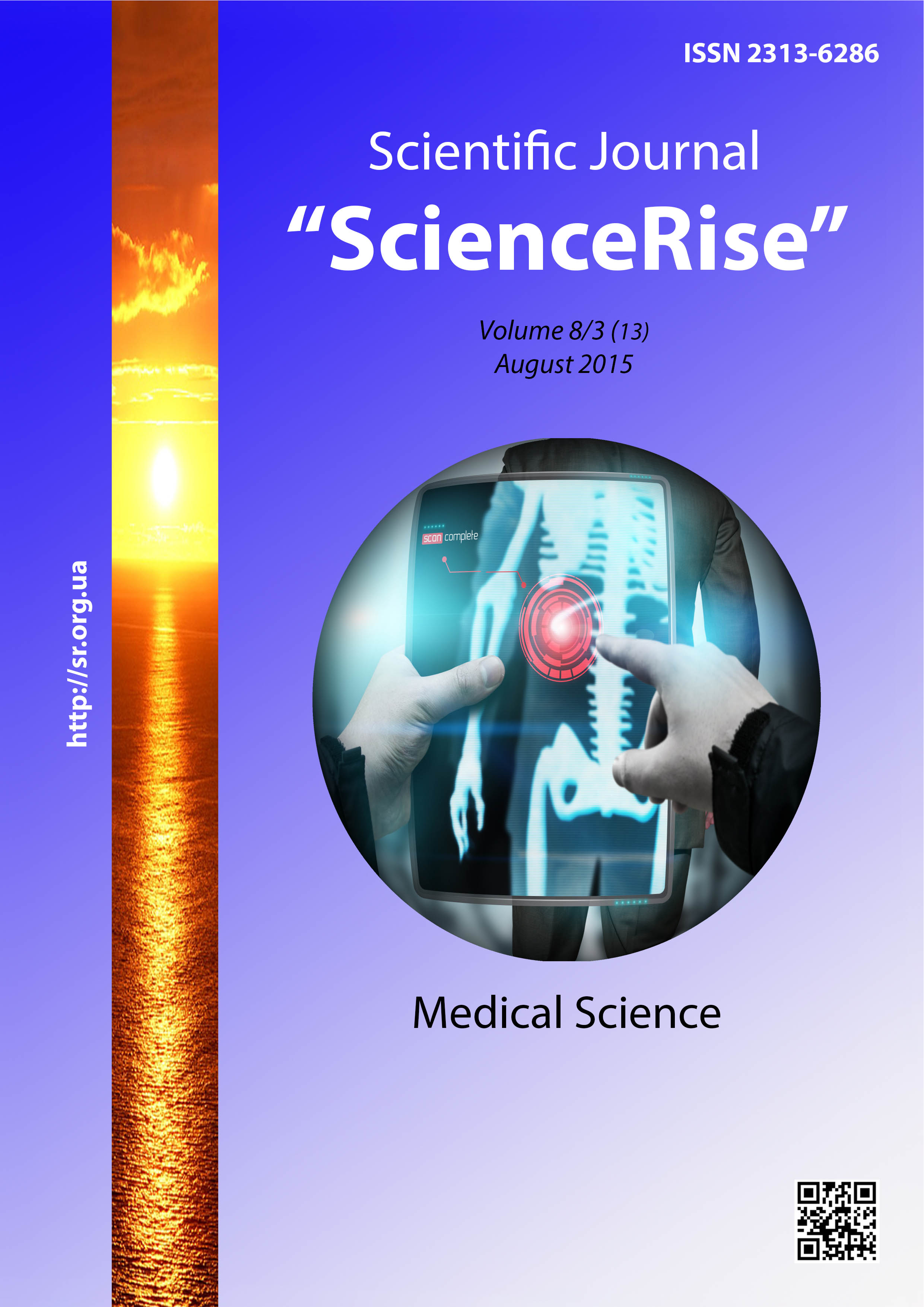The efficacy of fluticasone propionate nebulizer therapy in children with laryngotracheitis
DOI:
https://doi.org/10.15587/2313-8416.2015.48203Keywords:
laryngotracheitis, laryngotracheobronchitis, children, fluticasone propionate, nebulizer therapy, glucocorticoidsAbstract
Objective. To determine the efficacy of fluticasone propionate (FP) nebulizer therapy in children with laryngotracheitis (LT)
Methods. There were children with LT and laryngotracheobronchitis (LTB) aged 0–13 years under observation. 97 children with an initial Westley score 1-5 received nebulized FP 0.5 mg every 6 hours up to no stridor. 104 controls matched by age, sex and severity received systemic glucocorticoids intramuscularly or intravenously. The efficacy of treatment was assessed with a total dose of glucocorticoids used and with duration of treatment up to Westley score 0. We compared effectiveness of therapy in both groups
Results. FP treatment was associated with a significant improvement in symptoms in patients with mild LT and LTB (Westley score 1-3) at 6 hours, in patients with moderate LT and LTB (Westley score 4-5) – at 12 hours.
The improvement was slower in case of LTB than in LT. A total dose of FP used in children with mild LT and LTB up to Westley score 0 was 0,68±0,42 mg, in children with moderate LT and LTB – 1,1±0,81 mg versus 3,23±3,69 mg / kg and 4,43±3,77 mg / kg respectively as to prednisolone equivalent doses of systemic glucocorticoids in controls. The duration of treatment up to Westley score 0 was shorter in children treated with FP compared to controls
Conclusion. Nebulized FP is effective in relieving the symptoms of mild to moderate LT and LTB
References
Cherry, J. D. (2008). Clinical practice. Croup. New England Journal of Medicineed, 358 (4), 384–391. doi: 10.1056/nejmcp072022
Westley, C. R., Cotton, E. K., Brooks, J. G. (1978). Nebulized Racemic Epinephrine by IPPB for the Treatment of Croup. American Journal of Diseases of Children, 132 (5), 484–487. doi: 10.1001/archpedi.1978.02120300044008
Mazza, D., Wilkinson, F., Turner, T., Harris, C. (2008). Health for Kids Guideline Development Group. Evidence based guideline for the management of croup. Aust Fam Physician, 37 (6), 14–20.
Bjornson, C. L., Johnson, D. W. (2013). Croup in children. Canadian Medical Association Journal, 185 (15), 1317–1323. doi: 10.1503/cmaj.121645
Bjornson, C., Russell, K. F., Vandermeer, B., Durec, T., Klassen, T. P., Johnson, D. W. (2011). Nebulized epinephrine for croup in children. Cochrane Database Syst Rev, 2. doi: 10.1002/14651858.cd006619.pub2
Russell, K. F., Liang, Y., O'Gorman, K., Johnson, D. W., Klassen, T. P. (2011). Glucocorticoids for croup. Cochrane Database Syst Rev, 1. doi: 10.1002/14651858.cd001955.pub3
Sparrow, A., Geelhoed, G. (2005). Prednisolone versus dexamethasone in croup: a randomised equivalence trial. Archives of Disease in Childhood, 91 (7), 580–583. doi: 10.1136/adc.2005.089516
Fifoot, A. A., Ting, J. Y. (2007). Comparison between single-dose oral prednisolone and oral dexamethasone in the treatment of croup: A randomized, double-blinded clinical trial. Emergency Medicine Australasia, 19 (1), 51–58. doi: 10.1111/j.1742-6723.2006.00919.x
Chub-Uppakarn, S., Sangsupawanich, P. (2007). A randomized comparison of dexamethasone 0.15mg/kg versus 0.6mg/kg for the treatment of moderate to severe croup. International Journal of Pediatric Otorhinolaryngology, 71 (3), 473–477. doi: 10.1016/j.ijporl.2006.11.016
Bjornson, C. L., Klassen, T. P., Williamson, J., Brant, R., Mitton, C., Plint, A. et. al. (2004). A Randomized Trial of a Single Dose of Oral Dexamethasone for Mild Croup. New England Journal of Medicine, 351 (13), 1306–1313. doi: 10.1056/nejmoa033534
Çetinkaya, F., Tüfekçi, B. S., Kutluk, G. (2004). A comparison of nebulized budesonide, and intramuscular, and oral dexamethasone for treatment of croup. International Journal of Pediatric Otorhinolaryngology, 68 (4), 453–456. doi: 10.1016/j.ijporl.2003.11.017
Berezhnoi, V. V., Kozachuk, V. G., Glyadelova, N. P., Korneva, V. V., Koroleva, V. A., Lischinskaya, M. R. (2012). Sovremennyye aspekty terapii ostrogo stenoziruyushchego laringotrakheita u detey [Modern aspects of threatment of stenosing laryngotracheitis in children]. Sovremennaya pediatriya, 5, 57–61.
Carlsen, K. C. L., Stick, S., Kamin, W., Cirule, I., Hughes, S., Wixon, C. (2005). The efficacy and safety of fluticasone propionate in very young children with persistent asthma symptoms. Respiratory Medicine, 99 (11), 1393–1402. doi: 10.1016/j.rmed.2005.04.008
Adams, N. P., Bestall, J. C., Jones, P. W., Lasserson, T. J., Griffiths, B., Cates, C. (2008). Inhaled fluticasone at different doses for chronic asthma in adults and children. Cochrane Database Syst Rev, 4. doi: 10.1002/14651858.cd003534.pub3
Roorda, R. J., Walhof, C. M. (1998). Effects of inhaled fluticasone propionate administered with metered dose inhaler and spacer in mild to moderate croup: a negative preliminary report., 25 (2), 114–117. doi: 10.1002/(sici)1099-0496(199802)25:2<114::aid-ppul7>3.0.co;2-n
Downloads
Published
Issue
Section
License
Copyright (c) 2015 Лариса Михайловна Станиславчук

This work is licensed under a Creative Commons Attribution 4.0 International License.
Our journal abides by the Creative Commons CC BY copyright rights and permissions for open access journals.
Authors, who are published in this journal, agree to the following conditions:
1. The authors reserve the right to authorship of the work and pass the first publication right of this work to the journal under the terms of a Creative Commons CC BY, which allows others to freely distribute the published research with the obligatory reference to the authors of the original work and the first publication of the work in this journal.
2. The authors have the right to conclude separate supplement agreements that relate to non-exclusive work distribution in the form in which it has been published by the journal (for example, to upload the work to the online storage of the journal or publish it as part of a monograph), provided that the reference to the first publication of the work in this journal is included.

